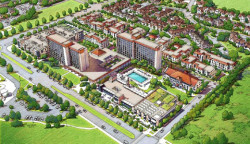Hannah Nelson
Staff Writer
UCSB Housing and Residential Services will be in the process of constructing the new university housing site San Joaquin — an apartment complex to be located north of Santa Catalina Residence Hall that has recently captured the attention of local community members.
To accommodate the growing influx of students, Housing and Residential Services initially launched plans for San Joaquin in 2006, and are expecting to begin construction within the next two years, at the earliest. However, local residents from Storke Ranch — the residential community located behind Santa Catalina Residence Hall — have expressed concerns about the new housing development during recent public meetings at Santa Catalina.
According to Alissa Hummer, acting director of Campus Planning and Design, the apartments will be built north of Santa Catalina and new dining commons will replace the bike parking lot on El Colegio Road, with other new parking lots to be built elsewhere. The apartments will range in height from two to six stories in order to not to shadow surrounding homes and are expected to provide housing for 1,000 students — including sophomores, juniors and seniors.
The housing project is part of the Long Range Development Plan of the university — which was jointly approved by UCSB, Santa Barbara County and the City of Goleta in 2010 — and since the university is a state institution, approval for the project does not have to undergo Board of Supervisors meetings. Instead, there have been several meetings held in Santa Catalina, where local residents and other community members have voiced their concerns.
Resident Hall Assistant Jorge Villela, a third-year history of public policy major who has been an RA for two years, said the addition of new residence halls, new dining commons and new businesses could establish a sense of community in the otherwise isolated area near Santa Catalina.
“I think with that interaction with the stores, and of course the new residence halls or apartments they’re building … could build a lot more connections [between] the first-years and the people that live in San Joaquin,” Villea said.
But according to Santa Barbara County Third District Supervisor Doreen Farr residents of Storke Ranch have expressed concerns about the number, size and height of the proposed buildings, as well as their proximity to homes in Storke Ranch. Many individuals have also said there could potentially be negative effects such as prospective business competition and harsh environmental impacts and hazards posed by a fault line running through the site. Additionally, there have been concerns over the safety of pedestrian and cyclists since there could be a widening of Storke Road to four lanes, as well as the creation of a possibly dangerous intersection at Storke Road and El Colegio.
However, Farr said UCSB and Santa Barbara County have maintained open communication and collaboration regarding the project, and said the university has yet to receive approval from the UC Board of Regents.
“My staff and I continue to be in close contact with UCSB administrators about this proposed project, and they have been very good about keeping us informed about their progress,” Farr said. “I understand they are planning to present this project to the Regents at their March meeting to gain preliminary approval for these plans.”
According to Barry Colwell, coordinator of resource planning for Housing and Residential Services, the project has been evolving with the involvement of the California Coastal Commission and has recently revised its budgetary process.
“We’ve had meetings with neighbors so we can make it as reflective of what we need, what students are asking for and what’s acceptable to neighbors,” Colwell said. “We’re trying to find the combination that works for everyone.”
The university’s Long Range Development Plan includes goals that focus on increasing student enrollment and providing housing for new prospective students, with plans to achieve these aims by 2025, Colwell said.
Furthermore, there is considerable potential for increasing enrollment since the state has identified UCSB as a campus that could offer enrollment to 25,000 students and currently serves just over 21,000 students.
“The university wants to house at least half of enrolled students in university housing, in reaction to the students’ needs and increased enrollment at UCSB,” Colwell said.
In fact, the campus has already seen the impact of growing enrollment numbers, according to Colwell, who said the large number of freshmen dorm triples seen this year is just one result of these rising rates. Colwell also said that while housing in Isla Vista is an option, it is not ideal for everyone.
“San Joaquin is only one of a number of projects. There’s additional growth planned on campus,” Colwell said. “What’s interesting is that this site is being enhanced with a lot of student amenities as well.”
According to Colwell, a new gym may take the place of the Portola dining commons, and a mini-market, café, pool and volleyball and basketball courts may also accompany the apartments.
Some students think San Joaquin and its amenities could allow students living in a more removed part of the campus to engage in more interaction with one another.
“The only people I hang out with right now are those who live in San Cat, so it would make it more of a social place,” Marla Cole, a first year pre-biology major, said.
Colwell said construction plans are still being developed and there still have been no set dates for building to start.

















